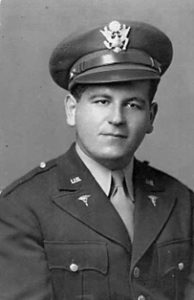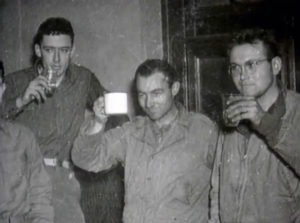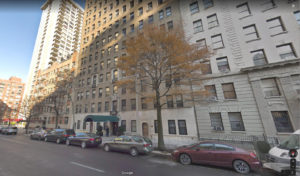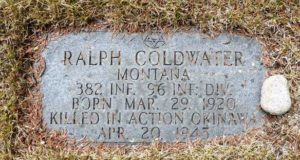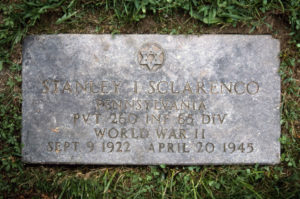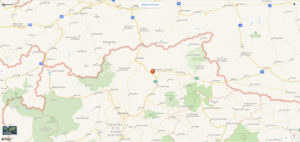This is the 37th post in an ongoing series of of accounts concerning Jewish WW II military casualties from the New York metropolitan area, whose stories were covered by The New York Times in 1944 and 1945. Paralleling the format of the 36 “prior” posts – encompassing Navy Hospital Apprentice 1st Class Stuart Adler through most recently (in January of 2020; was it that long ago?!) Army PFC Warren W. Jacobs – included are accounts of other Jewish military personnel who were casualties (killed, wounded, or prisoners of war) or who had vastly less dire but still notable experiences on the same “calendar” day.
The date of “today’s” post? Friday, the twentieth of April in the year 1945, when Captain Paul Kamen, PFC Donald R. Lindheim, and PFC Arthur N. Sloan, all of the United States Army ground forces, were killed in action in the European Theater of War.
Though obituaries of these three men appeared in the Times – on May 25, May 15, and June 5, 1945, respectively – the commonality of the “timing” of their fate, as Jewish soldiers, naturally remained entirely unaddressed by that newspaper. (In this, there is a parallel to the paper’s coverage of 2 Lt. Arthur M. Chasen and Sgt. Alfred R. Friedlander.) This was not surprising, for this was entirely consistent with the Times’ ethos concerning the identity, survival, and historical fate of the Jewish people in the Second World War (the religion of the Times, if any, being the “religion” of the Enlightenment) echoes of this ideology having steadily animated the newspaper’s reporting and editorial opinion about the nation-state of Israel. Yet…to be completely honest, in the particular context of the Second World War, this perception (or more accurately, non-perception) of Jewish military service seems to have been prevalent in the American Jewish press as much as in the general press.
____________________
But (but?!) … Before proceeding further…here’s something completely different. Well, kind of different. Well, just plain different.
Following the “example” (thus-far-only-one-example!) established by my blog post about HA1C Stuart E. Adler – pertaining to Jewish military casualties of March 15, 1945 – where is displayed the cover of the March, 1945 issue of Astounding Science Fiction – here’s parallel kind’a picture: The cover of the April 1945 issue of Astounding Science Fiction, featuring William Timmins’ illustration of a scene from Isaac Asimov’s story “Dead Hand”, which tale would in a few short years become part of Isaac Asimov’s Foundation Trilogy. But, that’s the topic of another blog post…
After all, given that this post pertains to events in that very month and year, an actual physical artifact from that time – however topically unrelated – does lend a sort of temporal “atmosphere” to the names and stories appearing below.
After all, whether symbolically or in reality; whether as myth or legend; whether remembered or forgotten (and more often forgotten); the past still exists.
And now, back to the central topic at hand…
____________________
As I climbed into the command car for the drive to my new CP, in Klein, I asked the inevitable question, “Who was it, Mike?”
“You won’t believe it, Colonel. It’s your chess-playing buddy.”
“Not Kamen!” I felt dizzy as the face of Dr. Paul Kamen, the battalion dentist, flashed before my eyes. “How did our medics get involved in a shootout?”
_____
A Dental Officer in the Army’s 291st Engineer Combat Battalion, Captain Paul Kamen (0-519788) was killed when his Battalion, advancing through Germany, was strafed by Me-262 jet fighters on April 20, 1945.
According to the Schlenoff-Kaminsky family tree at Ancestry.com, Paul Kamen and his twin brother Saul were born on January 24, 1916 in Brooklyn, New York, to Dr. and Mrs. Max Abraham [12/15/89-12/4/55] and Devora “Vera” (Brovinsky) [7/16/83-9/25/74] Kaminsky. Paul and his wife Anne were married on June 12, 1940 in Manhattan.
His name appearing in a Casualty List published on May 16, 1945, Captain Kamen was the subject of news articles in the Times (May 25), the Long Island Daily Press (May 17), and the Long Island Star Journal (May 16 and November 29 of 1945, and November 17, 1948) His name also appeared in the “In Memoriam” section of the Times on January 24 of both 1946 and 1947, in commemoration of the 30th and 31st anniversaries of his 1916 birth.
Here is Capt. Kamen’s obituary as it appeared in the Times:
Dentist From Sunnyside Killed in Action in Reich
May 25, 1945
 Capt. Paul Kamen of the Army, a dentist, formerly of Sunnyside, Queens, was killed in action in Germany on April 20, according to word received here. He was 29 years old.
Capt. Paul Kamen of the Army, a dentist, formerly of Sunnyside, Queens, was killed in action in Germany on April 20, according to word received here. He was 29 years old.
Born in Brooklyn, he received a B.A. degree from New York University in 1937 and a D.D.S. from Columbia University School of Dental and Oral Surgery in 1941.
He entered the Army in May, 1943, as a first lieutenant, went to England in February, 1944, and landed in France in July with the medical detachment of the 291st Engineers Battalion. He served his battalion as dental, public relations and orientation officer. His unit helped hold the enemy back in the Malmedy sector during the Ardennes break-through, winning the Presidential Unit Citation. It also threw one of the first bridges across the Rhine at Remagen.
Captain Kamen leaves a widow, Mrs. Anne Kamen; his parents, Dr. and Mrs. Max Kaminsky; a twin brother, Dr. Saul Kamen, and three sisters, Mrs. Anna Ratner, Mrs. Rebecca Jarmon and Mrs. Mina Gudeon.
____________________
Here are two articles about Captain Kamen from the Long Island Star Journal.
This first article coincided with the May 16 appearance of Captain Kamen’s name in the Office of War Information’s Casualty List, the Star Journal’s article curiously having been published a week before the Times’ May 25 article.
Sunnyside Dentist Killed in Germany
May 16, 1945
Captain Paul Kamen, former Sunnyside dentist, was killed in action in Germany April 20, his twin brother, Dr. Saul Kamen of Forest Hills and Elmhurst, has been notified.
The 29-year-old officer, who practiced at 47-09 Skillman Avenue before joining the Army in May 1943, was a dentist with the 291st Combat Engineers, attached to the 1st Army. He also performed the duties of public relations and orientation officer for his unit, and held a Presidential Unit Citation for heroism in Belgium during the enemy breakthrough in December.
Born and educated in Brooklyn, Captain Kamen received his degree in dentistry from Columbia University in 1941. Formerly a member of the Queens District Dental Society, he entered the army as a first lieutenant and was promoted to captain three months after going overseas in February 1944.
In addition to Dr. Kamen, who lives at 118-16 Queens Boulevard, Forest Hills, and has an office at 63-52 Woodhaven Boulevard, Elmhurst, the Captain leaves his wife, Mrs. Anne Kamen of 104-21 68th Street, Forest Hills, and parents, Dr. and Mrs. Max Kaminsky of 234 Hewes Street, Brooklyn. Dr. Kamen is chairman of the Queens legislative Council.
Six months later, on November 29, the Star Journal carried a brief news item about a check made to the American Committee for Yugoslav Relief by Dr. Saul Kamen, Paul’s twin brother, and the donation of Captain Kamen’s uniforms to the Committee by Paul’s widow Anne. Note that Paul’s portrait in the Star Journal differs from the image in the Times.
Even in Death
War Hero Contributes to Relief of Victims
November 29, 1945
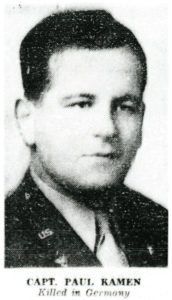 When Captain Paul Kamen of Elmhurst was killed in action in Germany last summer, a blank check was found among his personal effects.
When Captain Paul Kamen of Elmhurst was killed in action in Germany last summer, a blank check was found among his personal effects.
The check was sent to Dr. Saul Kamen of 63-52 Woodhaven boulevard, Elmhurst, who felt his brother would have wanted the money to go to the Yugoslav people whose sacrifices in the war left them homeless and in rags.
In due time, a check for $10 arrived at the American Committee for Yugoslav Relief, 235 East 11th street, Manhattan.
Today, Burgess Meredith, chairman of the winter clothing campaign of the committee, paid tribute to Captain Kamen and revealed that the captains’ widow had contributed his uniforms to the committee.
____________________
Not forgotten: Captain Kamen’s memory has been commemorated by two Honoree Records at the National WW II Memorial: One created by his brother Saul, and the other created by his widow Anne. The latter includes even a third photographic portrait of the Captain (in a pensive mood?) shown below:
Captain Paul Kamen was buried at Montefiore Cemetery (Block 111, Row 001L, Grave 1, Plot 12) in Springfield Gardens, New York, probably in late 1948.
Insights into Captain Kamen’s military experiences can be found in Danny S. Parker’s 2013 Fatal Crossroads: The Untold Story of the Malmédy Massacre at the Battle of the Bulge, Janice Holt Giles’ 1970 The Damned Engineers, which chronicles the story of the 291st Engineer Combat Battalion, and above all Colonel David E. Pergrin and Eric M. Hammel’s 1989 First Across the Rhine – The 291st Engineer Combat Battalion in France, Belgium, and Germany. (“Above all”, because Colonel Pergrin was commander of the Battalion!) All three excerpts pertain to the Malmedy Massacre – particularly the survival of Lieutenant Virgil Lary – while First Across the Rhine addresses the efforts of the 291st to aid Belgian civilians after Malmedy was inadvertently struck by bombs from American 9th Air Force B-26 bombers on December 23, 1944, and, concludes with an account of Captain Kamen’s death shortly before the war’s end.
Relevant excerpts these works follow below…
Fatal Crossroads
At about 9 p.m. they were all inside saying their prayers. “Someone rapped on my door,” she recalled. “We thought it was our turn to die.”
Her sister Marie was nearest to the entrance. “I’ll go and open it.” When she did, the silhouette of a big man stood there in the darkness of the doorway. “He was saying something, but we didn’t understand him.” Was he German? The girls looked at each other, but their father Louis, said to let him enter. Now, with the stranger inside, the kerosene lamp illuminated the room. They could see that he could hardly walk.
The man looked terrible – muddy and wet, limping on one foot and smudged and rank with cow dung. His boot was oozing red, and blood trailed onto the floor. He kept saying something over and over – “Sick! Sick!” – but no one could understand. There was small relief when they realized he was an American. But the Germans who had shot him must be close by. If they came…. The family sat him down near the warmth of the kitchen stove. With a loud groan, they got the bloody boot off. The American had been shot through the ankle. They washed his wounds. As they bandaged him up and put a splint on his ankle, Marie, her father, and her sisters discussed the situation. In the dimly lit farm- house was a refugee boy from Elsenborn who spoke a little English.
Through the youth, the Martin family learned that the man’s name was Lt. Virgil Lary from the U.S Army. All his comrades – more than a hundred – had just been shot down south of Malmedy. Marine gasped at his description. “How did you find the house?” Louis wanted to know. Lary told them that he had crawled there on his hands and knees. He had gone through a little village that they knew must have been Hedomont – and no one wanted to open the doors. Even with drawn curtains, Lary had followed the dim window beacon emanating from the Martins’ kerosene lamps. The Belgian family looked at each other: The Germans would see them too!
The girls gave the woeful-looking soldier some soup while the family talked. They couldn’t hazard keeping the American here; it was way too risky. The Germans would be here soon. Knowing the danger, her father Louis went down to Malmedy with a note composed by Lt. Lary, asking for help. He returned only an hour later. Sure enough, Martin had found the first aid station in Malmedy and tried to get Dr. Paul Kamen, a medic with the 291st Engineer Combat Battalion, to send an ambulance. But Kamen refused, explaining that driving through enemy territory was too dangerous. He did, however, send back some sulfa drugs and bandages. Although those were welcome when Louis returned, Lary was now in increasing pain and insisted on getting to an American hospital. The family was of the same opinion, but for a different reason: If the Germans came, they would all be shot. Still, even with an improvised crutch made from a broom, Lary clearly could not walk himself. But accompanying the American would be suicide if Louis ran into the Germans.
However, knowing the enemy might think differently of women helping a wounded man, Marthe and her neighbor, Marthe Marx, volunteered to escort the American to Malmedy. Doing so was terribly dangerous, but it was the best of a series of poor options. Eventually Louis Martin consented. After midnight they left, with the two young women holding Lary between them, each cradling a shoulder. “We could hear gunfire in the night,” she remembered, worrying that they might run into the Germans. If they did, that would be it. She reminded Marthe Marx to speak only German, and if they ran into them, “to shut up and let me do the talking.”
Marthe Martin tried not to think about the risk, but she urged her friend to go faster with the limping American. They kept moving – a three-kilometer march down a steep hill carrying an adult man between them. For over an hour Lary groaned in pain as they proceeded, and both girls ached terribly under his weight. Still, they eventually came to the school building in Malmedy used as the 44th Evacuation Hospital. There, a harried member of the Belgian Red Gross offered little help. “Sorry, we can’t take him,” the woman complained. “The whole unit is evacuating.” The Germans were coming. “For the love of God,” Marthe Martin said in exasperation. “Take this poor soldier to the Americans.” Okay, the woman agreed.
Marthe Martin and Marthe Marx uttered a quick goodbye to Virgil Lary. With that, both women hurried back up the steep hill to their home, expecting to run into the Germans at anytime. Shortly afterward Lt. Lary was taken to the command post of Lt. Col. David Pergrin and then to the 28th General Hospital in Liege. (pp. 217-218)
The Damned Engineers
Around 8:00 that evening, Warrant Officer Coye R. Self reached Malmedy with the ammunition, mines and demolitions Colonel Pergrin had ordered from Battalion earlier.
The supplies were quickly funneled out to the men on the various roadblocks. Especially strengthened was the area west of Malmedy where Sergeant McCarty now had two roadblocks on the main Stavelot road. He had one at the wooden bridge over the Warche River, and another at the big railroad viaduct. Mines and demolitions were sent and McCarty and Lieutenant Rhea set to work to wire the two bridges.
Pergrin was still, however, very short of machine guns. His officers kept asking for more and more machine guns for the roadblocks. He thought of Company A. They might be back home by now. He therefore radioed Battalion to send him the Company A machine guns and gunners. It was about 8:30 p.m. Battalion acknowledged and reported that Company A had not yet got in.
Between 8:30 and 9:00 p.m. Captain Paul Kamen, the battalion dental officer, arrived in Malmedy with more medics and medical supplies. Pergrin was amazed to see him. When he had radioed Battalion, he had ordered the medical officer over. Kamen explained that the medical officer, Captain Walter Kaplita, had not been in Haute Bodeux when Pergrin’s radio message was received. Not wanting to delay, Kamen had reasoned that he knew more about administering drugs and deep dressings than the medics and that in a pinch he might even be able to perform simple surgery, so he had packed up and come ahead.
Artillery fire was now falling in Malmedy. “Any trouble getting here?” Pergrin asked.
“Well,” Kamen said, “the truck got shot up pretty bad, but we got through. We came through a heavy bombardment on the road from Stavelot.”
Pergrin went out to look at the panel truck Kamen had brought and could only shake his head. The body was literally riddled with holes. “How in the hell did you make it without somebody being killed?” he said.
Kamen did not know. He thought perhaps they had been driving too fast. Not a man had received so much as a scratch. Kamen plunged immediately into work dressing the wounds of survivors from the massacre who continued to be brought in. Although the flow of wounded survivors would cease, Kamen’s work would not. For ten days he would be a very busy dental officer doing a medical officer’s work. (pp. 194-195)
Around midnight the last of the survivors of the massacre the 291st would assist was brought into the aid station. He was Lieutenant Virgil T. Lary. He had fallen into the friendly hands of a farmer who was a Belgian patriot rather than a German sympathizer. He was given assistance and shelter. He wrote a note addressed to the hospital commandant in Malmedy and asked that an ambulance be sent for him. The farmer took it to Malmedy where he learned that the hospital was no longer there. He persisted in his search for help for Lary, however, until he located Company B’s command post and aid station, where he delivered the note. Captain Kamen told him that he had no ambulance and the station was full of other wounded men who needed the attention of himself and his medics. Kamen sent sulfa and bandaging for Lary and the farmer promised to bring him in.
Returning to his farm, when Lary’s wound was dressed the farmer found a stout stick and his daughter Marthe and her friend, Marthe Manx, assisted the wounded officer into the aid station. It was nearly midnight. Colonel Pergrin interrogated him shortly afterward. Lary was able to give the final confirmation, clearly, concisely and coherently of precisely how the massacre had occurred. Colonel Pergrin said, “Lary was in perfect control of himself, calm and collected. He related the entire sequence of events coherently and in good detail. There was no evidence of hysteria. Like a good officer, he made a good, clear report.”
Between 3:30 that afternoon and midnight, seventeen survivors in all had made their way to places where men of the 291st could help them. It is known that 43 survivors of both the brief skirmish and the massacre lived and reached safety. There are 72 names on the monument erected by the Belgians in honor of the men massacred at the crossroads. The official records, however, list 86 names. A bleak testimony to the savagery of Peiper’s troops. (pp. 201-202)
*******
Then they were assigned to the 99th Infantry Division for the reduction of the Ruhr. When that had been done, the 99th, and the 291st with it, were assigned to Patton’s Third Army and they all went speeding down into Bavaria. The primary objective was to liberate as many prisoner-of-war camps as possible and to prevent any movement of German High Command to the redoubts in the southern mountains.
They lost three men during this movement. Captain Paul Kamen, who had brought the medical supplies to Malmedy through Pieper’s artillery fire the night of December 17, was killed on the autobahn near Kissengen. The 291st convoy was strafed by a couple of Luftwaffe jet-propelled planes. Staff Sergeant Douglas Swift, also of the medical section, was killed at the same time. (pp. 374-375)
____________________
First Across the Rhine
Shortly after midnight, a Belgian farmer named Martin was passed through one of our roadblocks to Dr. Paul Kamen’s aid station in Malmedy. Martin told Kamen that a wounded American officer was at his home, a farmhouse just south of town. Paul sent sulfa and bandages home with the farmer, and Martin returned at about 0100 hours, December 18, with Lieutenant Virgil Lary, commander of the massacred Battery B. As it turned out, Lary was the last of twenty-nine survivors we had taken in since 1530 hours, December 17. Though wounded, he was in good mental condition and quite able to relate a perfectly coherent story with many new details, including a complete description of the SS armored vehicles and a fairly accurate accounting of the German column’s strength. (p. 113)
____________________
… No, Malmedy’s worst enemy after December 21, 1944, was the U.S. Army Air Forces.
On December 23, beneath cloudy skies, twenty-eight B-26 medium bombers of the U.S. 9th Air Force’s IX Bombardment Division got confused on their way to the German town of Zulpich, which was thirty-three air miles from Malmedy. Twenty-two of the twenty-eight pilots eventually realized they were off course and aborted their bombing runs. However, six of the medium bombers dropped a total of eighty-six five-hundred-pound general-purpose bombs on Malmedy.
All of the bombs detonated around and through the center of town. Though severely dazed and shocked, Captain Larry Moyer, Captain John Conlin, and I immediately went to work organizing rescue efforts by al of our available troops – including many we pulled off the defensive barrier.
The town center was devastated. Fires were raging among the many collapsed buildings, roads and streets were thoroughly blocked, and there was ample evidence – screams, mainly – that many civilians and soldiers were buried alive in the rubble.
Among the first help to arrive was an engineer fire brigade organized by three of the 291st engineers running our eater purification plant – Technician 5th Grade John Chapman, Private First Class Camillo Bosco, and Private First Class John Iles. The makeshift fire brigade came complete with a fire truck and hoses.
As our line engineers converged on the ravaged area, Larry Moyer and John Conlin quickly organized rescue teams to sift through the rubble in search of survivors. Bulldozers arriving on the scene were deployed to begin road-clearing operations under the direction of Lieutenants Frank Rhea, Wade Colbeck, Don Davis, Kohn Kirkpatrick, and Leroy Joehnck and Master Sergeant Ralph McCarty. This was especially ticklish work near the center of the bombed-out area, for the rubble blocking the streets was likely as not to contain buried survivors. At the far edges of the blasted area, Sergeant Charles Sweitzer’s demolitions team blew fire lanes to contain the further spread of the otherwise uncontrollable fires.
Within minutes of the detonation of the last bomb, Captain Paul Kamen’s makeshift battalion aid station was receiving the first of the many, many military and civilian casualties. Shortly, litter teams were organized by several of our squad leaders – Sergeants Sheldon Smith and Al Melton, and Corporal Black Mac MacDonald. Unfortunately, the shortage of medics left the onerous task of separating the dead from the wounded to these three stalwarts. Too soon, lines of dead civilians and soldiers were being deposited in an open temporary morgue in the schoolyard near the aid station. By the time the last living victim had been freed from the rubble, Paul Kamen – our dentist – and his medics had treated about a hundred civilians and fifty GIs. Among the injured troops was Technician 3rd Grade Mack Barbour, an irrepressible medic who went straight to work as soon as his wounds had been bound.
My troop leaders and troops were magnificent. As I walked through the rubble, finding very little that needed my attention, there rose in me a sense of pride even the events of the past week could not surpass. Their reaction to the unbelievably frightening disaster had been so quick, so thorough, so giving. Almost without let up, these combat-hardened young men worked straight into the night, gingerly sifting the rubble of countless buildings for some sign of even the most tenuously maintained spirit of life.
Locating the living – and the dead – in the rubble was more difficult than it sounds. The mighty detonations of the five-hundred-pound-bombs had ground many parts of many buildings to a fine, powdery gray dust which coated everything in sight. A living, unconscious body looked much the same as dead stone, and more than a few survivors were located only after they gave way beneath the boot-shod feet of would-be rescuers. There was no blood visible – only less-dry blood-charged patches of the ubiquitous gray dust. And throughout the effort, the strenuous breathing resulting from heavy, frantic physical effort carried great volumes of the noxious fine powder and cordite-tinged are into the noses, mouths, and lungs of the rescuers.
Many of the tableaux we uncovered were simply pitiful. Master Sergeant Ralph McCarty and Technician 5th Grade John Noland lifted some heavy rubble from the ruin of one house and found several live children arrayed around the cold, stiff bodies of their mother and father. Children and adults whose clothing had been reduced to gray, dusty rags wandered aimlessly through the area of the worst destruction, all no doubt driven temporarily over the edge by the shock and grief that had burst upon their comparatively orderly lives. (It is one thing to see a war going on, and quite another to have that war explode in your family’s sitting room.)
We eventually learned that the BBC had reported Malmedy as being in German hands, and we chalked the error up to that bad information. We had placed many huge marker panels on roofs throughout the town, but low clouds apparently obviated their being seen in time. However, a subsequent investigation revealed that it was a navigation error, pure and simple. I cannot imagine what would have befallen us had all or most of the B-26s dropped their bombs. (pp. 173-175)
____________________
The Germans quit the Ruhr region altogether on Sunday, April 15, 1945, three days after we were rocked by the news of the death of President Franklin Roosevelt. By then, all of our prisoner-of-war camps were filled beyond capacity by fit German soldiers who were clearly placing their lives and futures ahead of any remaining loyalty to the Nazi regime. Only the most rabid Nazis were still putting up appreciable resistance.
As the Allied armies in the West converged along a narrowing front and the Ruhr became a backwater, I took the opportunity of our relative inactivity to institute a major program of rest and recreation for my men. Every man we could spare from routine road and bridge maintenance duties was given an opportunity to wash, shave, and trade in worn clothing and shoes. Everyone who wanted to go was sent on fishing expeditions in the clear streams and lake that dotted our operational zone. We played hard at a wide variety of sports. As the transportation system sorted itself out, long leaves in Paris and Brussels became available on a limited basis.
The moment things settled into a routine, Mill McKinsey was back with his “order” that I leave for my vacation on the Riviera. By then, even I felt the need to take a break, so I acceded and joined a fellow lieutenant colonel from the 1st Army Engineer section for the flight to Cannes. The week passed in a blur of unwarlike activity. On the way back to the Ruhr, the pilot of our C-47 transport plane dipped low over Remagen so I could see the 291st’s handiwork. It was satisfying to see that the treadway pontoon bridge was as busy with traffic as it had been on its first day of business.
I was met at the airfield at Scheinfeld by good old Mike Popp. As I greeted my driver, I was struck by the look of despair on his face. Instantly, the positive effects of a week away from the grind dissipated in a shudder of fear. I knew instinctively that someone close to me had died. As I climbed into the command car for the drive to my new CP, in Klein, I asked the inevitable question, “Who was it, Mike?”
“You won’t believe it, Colonel. It’s your chess-playing buddy.”
“Not Kamen!” I felt dizzy as the face of Dr. Paul Kamen, the battalion dentist, flashed before my eyes. “How did our medics get involved in a shootout?”
“We were in a convoy, keeping up with the 99th Division on the way south. On April 20, the Krauts dive-bombed our column near a place called Kitzigen, south of Frankfurt.”
I wanted more details; I wanted to know how Paul Kamen, the hero medico of Malmedy, had died. Mike took a deep breath and laid it out. “We were in a motorcade, meeting no resistance, when we heard the Kraut jets coming down on us. All the trucks stopped and everyone hit the ditch. It was routine stuff, Colonel. We’d done it a hundred times since we crossed into Germany. Anyway, I was at the front of the column and the medical section was all the way in the rear. According to the guys who were back there, the medics never got out of their trucks. The jets hit them too fast. Doctor Kamen’s truck took a direct hit. He was killed instantly. They also got Doug Swift. We got Doug out, but he died in the hospital. Mack Barbour was with him when he died.”
I was dumbfounded, too overcome by grief to speak, so we finished the dive to the CP in silence. When we got there, Lieutenant Don Gerrity came out to greet me with what he hoped would be better news. “Five men from the H&S Company were wounded in the jet attack, Colonel, but,” and he held up his hand before I went crazy, “they’ve all been returned to duty. Nothing serious.” After Don told me who the wounded men were, I asked where I could find Technician 3rd Grade Mack Barbour. Don said that he would get Mack for me.
As soon as Mack walked into the CP, I asked how Paul Kamen had died. “He went right away, sir, as soon as the bomb got the weapons carrier. We were stopped before the bomb hit, but we didn’t have a chance to get out. I wasn’t touched. I checked his vital signs right away, but he was gone. Sir, there wasn’t a mark on him. It could have been the concussion or it could be his heart stopped from the shock of the explosion. We got him to the evac hospital and the doctors confirmed that he was gone.
“Master Sergeant Swift had abdominal wounds, but it looked like he was going to make it. I thought he’d make it, but he died during the same evening.” (pp. 304-306) (Born on March 1, 1911, S/Sgt. Douglas C. Swift, 38396893, of Seminole County, Ok., is buried at the Fairview Cemetery, in Shawnee, Ok. His tombstone incorrectly lists the date of his death as 4/30/45.)
____________________
On the odd hunch that at least some kind of historical record of the 291st had been preserved on film, I discovered the fifty-minute-long documentary – “The Damned Engineers in the Battle of the Bulge December 1944 (“U.S 291st Combat Engineer Battalion against Battle Group Peiper in the Battle of the Bulge in December 1944”). According to a bibliographical record at WorldCat, the film was produced in 1991 by “A & E [Arts & Entertainment Network] Home Video”, the producers having been Richard P. Maniscalco, John Flynn, Colonel Pergrin himself, and “Image Crafters”.
The title being self-explanatory to the documentary’s nature, the film – based on Colonel Pergrin and Eric Hammel’s First Across the Rhine – is excellent, incorporating both American and German archival footage, still photos and maps (well, images of maps). The video is of very good quality, while the audio narration is refreshingly not obscured by too-loud background theme music. As a nice and fittingly symbolic gesture – particularly in the context of the timing of its early 1990s production, when most WW II veterans were in their sixties and seventies and approaching or in retirement – it begins and concludes with the depiction of a veteran of the 291st (played by John Flynn) reviewing his wartime and memorabilia and reminiscing about his service in the 291st.
The film is hosted at Daniel Kneeland’s YouTube channel, but, you’ll have to log in to YouTube to view it, for it comes with the warning: “This video is age-restricted and only available on YouTube.” Gadzooks. Seriously? Why? Well, probably due to the inclusion of camera footage of the recovery and identification of soldiers murdered by the S.S. during the Malmedy Massacre (I’ve not seen these sequences before), film which even by the standards of cinema of WW II combat – and the aftermath of combat – is at once utterly graphic, appalling, and infuriating.
You can view the video at the link below, after – uhhh – logging in to YouTube.
Or more aptly phrased, TheirTube?
In this context, the documentary includes brief interviews with two survivors of that atrocity (James Mattera at both 21:53-22:11 and 22:45-23:12, and, Bill Merriken at 22:12-22:44), and towards the end, film of the Malmedy Massacre trial. This sequence includes (from 48:31 to 49:22) of film of Lieutenant Virgil P. Lary, Jr.
One of the several still images incorporated into the film appears from 43:46 to 44:09 – and shows Colonel Pergrin and his staff toasting the 291st’s defense efforts at Malmedy. As stated in the narration, “In the center was Colonel Pergrin, on the right Captain [Lawrence] Moyer and on the left Lieutenants [Thomas] Stack, Fitzpatrick, and Lieutenant Don[ald] Davis. Lieutenants Scoback and Ray, Captain Kamen the medic, and Captain Lloyd Sheetz, the liaison officer.”
Screen captures of the photo are shown below. Despite the narration, I’m uncertain of “who is who”, albeit Captain Kamen is standing second from left at the bottom of the three images, looking directly at the unknown photographer.
__________
Paul Kamen is among the many American Jewish WW II military casualties whose named are absent from the 1947 book American Jews in World War II.
____________________
The year 2001, fifty-six years after Captain Paul Kamen was killed in action in Germany, marked the release of Steven Spielberg (especially see this…) and Tom Hanks’ production of the television miniseries Band of Brothers, which presented a dramatized account of the history of E Company, 506th Parachute Infantry Regiment, 101st Airborne Division, inspired by Dr. Stephen E. Ambrose’s book of the same name.
(Digressing and getting very “off topic”: I’ve never viewed, and have never been interested in viewing, Band of Brothers. I did watch Saving Private Ryan, and found the film to be disquieting (albeit this feeling didn’t actually arise from its graphic nature as such) and above all, well – how can I put it?? – contrived, with sentimentality splashed on as if with a heavy trowel. Then again, I’ve never been impressed with Spielberg’s oeuvre, which excels as much in shallowness, a kind of forced, disingenuous, and calculated optimism, and an avoidance of historical reality, as it does simple cinematography – I’ll give him credit there. Okayyy, enough with the film criticism for now! Back to the post-at-hand…)
As I discovered while creating this post, the music for the series was written by the late composer Michael Arnold Kamen, Captain Paul Kamen’s nephew. As stated in the booklet accompanying the CD release of the music soundtrack, “This music was written as a requiem for Captain Paul Kamen, my father’s twin, who was killed at Remagen, 3 days before the end of the war. Rest in peace.” Well, while completely and oddly incorrect – the war in Europe ended on May 8, almost three weeks after Captain Kamen’s death, and the Captain was not killed at Remagen – the feeling and motivation are nonetheless quite real.
You can listen to the full 48-minute musical soundtrack of Band of Brothers here, at the Movie Themes Symphonies & Suites YouTube channel.
Born in 1948, Michael Kamen passed away in 2003 at the age of fifty-five, after an enormously prolific and successful musical career, as evidenced by the plethora of information about his life and body of work.
As summarized by Ron Moody at Michael Kamen’s biographical profile at FindAGrave:
Musician. Classically trained at New York’s Julliard School where he studied oboe, he gained fame as a Grammy winning and Oscar nominated composer. His first Grammy came in 1992 for the theme to “Robin Hood: Prince of Thieves” followed by a Grammy in 1996 for “An American Symphony” which he derived from his work on the musical drama “Mr. Holland’s Opus”. His most recent Grammy came in 2001 which he shared with Metallica for the song “The Call of Ktulu” for conducting the San Francisco Symphony Orchestra. He was nominated for Oscars for his work with Bryan Adams on “(Everything I Do) I Do It For You” from Robin Hood” and “Have You Ever Really Loved a Woman” from “Don Juan DeMarco”. During his career he also collaborated with such artists as Sting, Rod Stewart, David Bowie, Pink Floyd and Eric Clapton. He also provided the music for the “Lethal Weapon” and “Die Hard” movies. In 1997 he established the Mr. Holland’s Opus Foundation to raise money to make musical instruments available to the nation’s children.
You can read more about Michael Kamen at…
Wikipedia (…but of course…)
The Guardian (his obituary)
In all this, it would seem that past and future – whether by chance or inevitability – intersected with one another. Or, in the words of William Faulkner in Requiem for a Nun, “The past is never dead. It’s not even past.”
Photo from The Lounge Critic Blogspot
Photo via Ron Moody
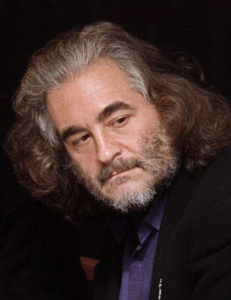
____________________
His obituary appearing in the Times on May 15, 1945, PFC Donald Robert Lindheim (39054015) of the 2nd Ranger Battalion received the Purple Heart.
Born on June 2, 1914 in New York City, he was married to Mrs. Mary (Tuthill) Lindheim, of 247 (347?) Union St., in San Francisco. His parents were Attorney and Mrs. Norvin Rudolf [1880-1928] and Irma (Levy) [1886-1978] Lindheim; his siblings Norvin Rudolf, Jr. [1/23/08-4/6/39], Richard W., Stephen W., and Mrs. Hortense L. Wheatley, the family residing at the Peter Stuyvesant Hotel in Manhattan (about which, see more below). He was a graduate of Cornell University.
PFC Lindheim is buried at the Netherlands American Cemetery, in Margraten, Holland (Plot J, Row 4, Grave 4). His name appeared in a Casualty List issued on May 15, 1945, as well as the New York Sun (April 8, 1939), Daily News (New York Daily News, that is) on May 18, 1945, and Jewish Chronicle (London) on June 1, 1945. His name can be found on page 48 of American Jews in World War II.
Ranger Who Lost His Life In Germany on April 20
May 15, 1945
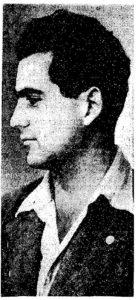 Pfc. Donald R. Lindheim of the Second Ranger Battalion of the Army was killed in action in Germany on April 20, the War Department has informed his family, it was announced yesterday. He was 30 years old. Private Lindheim was a son of Mrs. Irma L. Lindheim of the Peter Stuyvesant Hotel [The Peter Stuyvesant Hotel, at 257 Central Park West, was sold on April 17, 1967, becoming the Peter Stuyvesant Apartments, the name then being changed to the Orwell House. Resident shareholders finally changed the name to “257 Central Park West” by the early 2000s, the building’s present title.], who is a former president of Hadassah, the Women’s Zionist Organization of America, and of the late Norvin Lindheim, a lawyer.
Pfc. Donald R. Lindheim of the Second Ranger Battalion of the Army was killed in action in Germany on April 20, the War Department has informed his family, it was announced yesterday. He was 30 years old. Private Lindheim was a son of Mrs. Irma L. Lindheim of the Peter Stuyvesant Hotel [The Peter Stuyvesant Hotel, at 257 Central Park West, was sold on April 17, 1967, becoming the Peter Stuyvesant Apartments, the name then being changed to the Orwell House. Resident shareholders finally changed the name to “257 Central Park West” by the early 2000s, the building’s present title.], who is a former president of Hadassah, the Women’s Zionist Organization of America, and of the late Norvin Lindheim, a lawyer.
Born here, Private Lindheim attended the Tome School in Maryland and Cornell University. He studied and worked in collective agriculture in Palestine and at the time of an Arab uprising there acted as bodyguard to Dr. Chaim Weizmann, president of the World Zionist Organization. He was studying for a Doctor of Philosophy degree at the University of California when he enlisted.
Besides his mother Private Lindheim leaves a widow, Mrs. Mary Tuthill Lindheim of Tucson, Ariz.; two brothers, Lieut. Richard Lindheim of the Army Signal Corps, now in Burma, and Stephen Lindheim, in special Government service, and a sister, Mrs. John Wheatley of Yonkers, N.Y.
Here’s PFC Lindheim’s obituary, as it appeared in the Daily News; not that much different from as reported in the Times.
Daily News (New York)
May 18, 1945
A member of the 2nd Ranger Battalion, PFC Donald R. Lindheim, 30, son of Mrs. Irma L. Lindheim of the Peter Stuyvesant Hotel, was killed in action in Germany on April 20.
Lineheim once acted as bodyguard to Dr. Chaim Weizmann, president of the World Zionist Organization, at the time of an Arab uprising in Palestine. His mother is a former president of Hadassah, women’s Zionist organization. He was studying for a doctor of Philosophy degree at the University of California when he enlisted. Surviving also are Lindheim’s widow, Mrs. Mary Tuthill Lindheim of Tuscon, Ariz.; two brothers and a sister.
Here’s a view of 257 Central Park West, from Wikipedia (“The profile from the 86th Street transverse at Central Park.”)
Another view of the building. (“Hotel Peter Stuyvesant, ca. 1938.”)
This photo of PFC Lindheim, at his FindAGrave biographical profile, is via contributor ET.

____________________
The third April 20, 1945 casualty whose obituary appeared in the Times was PFC Arthur Neurad Sloan (42038875), a medic in the Medical Detachment of the 260th Infantry Regiment of the 65th Infantry Division, who died of wounds on April 21. He was awarded the Bronze Star Medal and Purple Heart.
The son of Dr. Alfred V. and Mrs. Jeanette Salomon and brother of S/Sgt. Alfred V. Sloan, Jr., of 41 West 96th Street in Manhattan, he is buried at Linden Hill Cemetery in Maspeth, N.Y.
PFC Sloan’s name appeared in Casualty Lists on May 14 and May 18, 1945, and in the Times’ Obituary section on July 16, 1948. His name can be found on page 447 of American Jews in World War II.
Youth Fatally Wounded While Helping Comrade
June 5, 1945
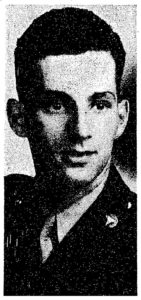 Pfc. Arthur N. Sloan, an Army medical aid man, son of Dr. and Mrs. Alfred V. Salomon of 41 West Ninety-Sixth Street, died on April 21 of wounds he suffered the previous day while attending a wounded comrade near Regensburg, according to word received here. He was 19 years old.
Pfc. Arthur N. Sloan, an Army medical aid man, son of Dr. and Mrs. Alfred V. Salomon of 41 West Ninety-Sixth Street, died on April 21 of wounds he suffered the previous day while attending a wounded comrade near Regensburg, according to word received here. He was 19 years old.
Born in this city he was graduated from Columbia Grammar School in 1943 and entered the pre-medical course of Washington Square College of New York University. He entered the Army in September, 1943, and went overseas in January, 1945. He saw active service with the Third Army in the Saar and later in Bavaria and Czechoslovakia.
Besides his parents he leaves a brother, S/Sgt. Alfred V. Sloan Jr. of the Army Air Forces.
Here’s an Oogle Street view of 41 West 96th Street in Manhattan.
____________________
Some other Jewish military casualties on Friday, April 20, 1945 (Yom Shishi, 7th Iyar, 5705) include…
– .ת. נ. צ. ב. ה –
תהא
נפשו
צרורה
בצרור
החיים
United States Army
Killed in Action / Died of Wounds
Adler, Samuel Ludwig, S/Sgt., 36774182, Bronze Star Medal, Purple Heart (Germany – died of wounds)
65th Infantry Division, 259th Infantry Regiment, K Company
Born Hungary, 10/4/10
Mrs. Goldie G. Adler (wife), 4748 N. Whipple St., Chicago, Il.
Lorraine American Cemetery, St. Avold, France – Plot F, Row 11, Grave 26
Chicago Daily Tribune 7/29/45
American Jews in World War II – 92
This image of S/Sgt. Adler is via FindAGrave contributor PJHorn.

Cite Veterans of Far Flung Battle Zones
Bronze Star Citations Tell of Bravery
Chicago Daily Tribune
July 29, 1945
The 65th Infantry Division in Austria recently honored the memory of Staff Sgt. Samuel L. Adler who gave his life wiping out a German machine gun nest. Son of Mrs. Lenas Geydushek, 4626 Monticello Ave., he was awarded the bronze star posthumously.
Adler’s act of heroism took place in the city of Neumarket [sic], Germany, last April. Leading his squad in clearing houses in Nermarket, he was pinned down by intense fire from an enemy machine gun nest to his front. He inched his way forward to discover the enemy’s position and when within 25 yards of his objective was fatally wounded by machine gun fire.
Sgt. Adler’s Bronze Star citation, at his FindAGrave biographical profile, reads as follows:
“For heroic achievement in connection with military operations against an enemy of the United States at Neumarkt, Germany, on 20 April 1945. Sergeant ADLER, a Company “K” squad leader, leading his squad in clearing houses in Neumarkt, was pinned down by intense fire from an enemy machine-gun nest to his front. Leaving his men under cover, Sergeant ADLER inched his way toward the enemy gun. Discovering their position, he informed his scout, and began an advance to wipe out the nest. When within twenty-five yards of his objective, he was fatally wounded by machine-gun fire. Sergeant ADLER gave his life protecting his comrades, and by his heroic devotion to duty enabled his squad to annihilate the enemy machine gun nest, thus contributing greatly to company’s advance”
Details: General Orders No. 23, Headquarters 65th Infantry Division (16 May 1945).
__________
Chelimsky, Joseph L., Sgt., 32999069, Bronze Star Medal, 1 Oak Leaf Cluster, Purple Heart
77th Infantry Division, 307th Infantry Regiment
Born 1916
Mrs. Virginia Chelimsky (wife), 11 Maple St., Brooklyn, N.Y.
Ms. Zita Fox (?)
Honolulu Memorial, Honolulu, Hawaii – Plot N, Row 1, Grave 385
American Jews in World War II – 288
Coldwater, Ralph, Pvt., 39931847, Purple Heart (Okinawa)
96th Infantry Division, 382nd Infantry Regiment
Born in Montana, 3/29/20
Mr. and Mrs. Lipman [2/16/88-2/16/77] and Henrietta [8/12/84-5/1/39] Coldwater (parents), Capt. Elliott Coldwater (brother)
303 East Park Ave., Anaconda, Montana
B’Nai Israel Cemetery, Butte, Mt.
Casualty List 6/10/45
American Jews in World War II – 219
This image of Pvt. Coldwater’s Matzeva, by Suzanne Andrews, appears at his FindAGrave biographical profile.
__________
David, Allan Lippett, 2 Lt., 0-1183680, Purple Heart (Philippines, Negros Island)
503rd Parachute Infantry Regiment, Headquarters Company, 2nd Battalion
Born 1924
Mr. Sigmund W. David (father); Martha L. David and Elinor S. David (sisters), 167 Maple St., Glencoe, Il.
Manila American Cemetery, Manila, Philippines – Plot N, Row 7, Grave 167
Chicago Tribune 5/17/45
Chicago Jewish Chronicle 6/1/45
American Jews in World War II – 96
Goldberg, Jack, PFC, 33935228, Silver Star, Purple Heart (died of wounds)
10th Mountain Division, 87th Mountain Infantry Regiment, D Company
Miss Jean Goldberg (sister), 3834 Wyalusing Ave., Philadelphia, Pa.
Florence American Cemetery, Florence, Italy – Plot F, Row 2, Grave 14
The Jewish Exponent 6/8/45
Philadelphia Bulletin 6/2/45
Philadelphia Inquirer 6/1/45
Philadelphia Record 6/2/45
American Jews in World War II – 524
__________
Markson, Harry F., Pvt., 12238636, Purple Heart, shot by a sniper at Monte Maygori, Italy
10th Mountain Division, 87th Mountain Infantry Regiment, G Company
Born Elmira, N.Y., 1926
Attorney Harry Markson (father) and Mrs. Mildred (Falk) [1892-1986] Markson (mother), 10 7th St., Buffalo, N.Y.
Florence American Cemetery, Florence, Italy – Plot C, Row 4, Grave 23
Casualty List 6/18/45
Buffalo Courier-Express 6/19/45, 9/27/45, 11/9/45
American Jews in World War II – 388
As described in the history of the 10th Mountain Division (page 111):
2nd Battalion – To the Valley
COMPANY G – TOMBA
Company G was given the mission of capturing the town of Tomba and clearing the ridge beyond to protect the battalion advance on their right. The company moved out at 0645, 3rd Platoon leading. Small arms fire held up the 3rd Platoon, and the 2nd Platoon passed through and took the right part of town.
The 1st Platoon, meanwhile, pushed up and took the section of town left of the road. Machine guns and mortars gave excellent overhead fire on the ridge from positions where they were receiving heavy artillery and mortar fire from the enemy.
After part of the town was taken, one squad of the 1st Platoon moved over onto the forward slope. They promptly received machine gun and sniper fire.
Pfc. HARRY F. MARKSON was killed by a sniper.
The following two photographs are via FindAGrave contributor Keith Redmond. The first image, a formal portrait taken in 1930, shows ten-year-old Harry with his mother Mildred, then thirty-eight years old.
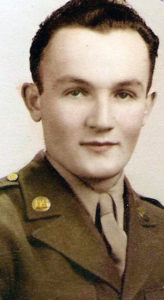
As reported in the Buffalo Courier-Express…
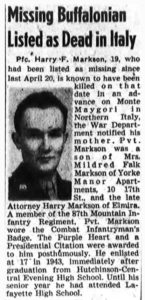
__________
Nathan, Marcus, Pvt., 33176598, Medical Corps, Purple Heart
77th Infantry Division, 302nd Medical Battalion
Born7/3/07
Mrs. Anna S. Nathan (wife) [1/11/96-12/20/83]
Mr. and Mrs. Harry [6/16/81-9/1/41] and Henrietta (Pincus) [2/23/80-3/7/51] Nathan (parents), 2738 N. 15th St., Philadelphia, Pa.
Anita, Harold H., Sidney, and Victor (sister and brothers)
Golden Gate National Cemetery, San Bruno, Ca. – Section N, Grave 1774
The Jewish Exponent 6/8/45
Philadelphia Inquirer and Philadelphia Record 5/30/45
American Jews in World War II – 541
Pearl, Joseph, 1 Lt., 0-1301870, Purple Heart
3rd Infantry Division, 15th Infantry Regiment, Communications
Born in Soviet Union, 1921
Mr. Jack Pearl (brother), 76-36 113th St., Forest Hills, N.Y.
Mr. Louis Pearl (father), 2100 Westbury Ct., Brooklyn, N.Y.
Employee of Richmond Lighting Company, Brooklyn
Lorraine American Cemetery, St. Avold, France – Plot E, Row 35, Grave 23
Long Island Star Journal 5/18/45
American Jews in World War II – 403
Ruffine, Barney S., PFC, 12030943, Field Artillery, Bronze Star Medal, Purple Heart (Philippines)
37th Infantry Division, 140th Field Artillery Battalion
Mr. Louis Ruffine (father), 118-02 Liberty Ave., Richmond Hill, N.Y. / 118-14 83rd Ave., Kew Gardens, N.Y.
Manila American Cemetery, Manila, Philippines – Plot A, Row 14, Grave 207
The New York Times (Obituary Section) 4/28/46
American Jews in World War II – 424
__________
Schorr, Morris (Moshe Bar Shlomo), Pvt., 33329311, Purple Heart
45th Infantry Division, 180th Infantry Regiment
Born 1919
Mrs. Esther Schorr (mother), Martin, William, and Mrs. Vera Malkin (brothers and sister), 2610 S. Warnock St., Philadelphia, Pa.
Mount Sharon Cemetery, Springfield, Pa. – Section I; Buried 12/12/48
Casualty List 5/23/45
The Jewish Exponent 6/1/45, 12/10/48
Philadelphia Inquirer 12/9/48
American Jews in World War II – 550
__________
Sclarenco, Stanley I., Pvt., 33940640 (at Treuf, Germany)
65th Infantry Division, 260th Infantry Regiment
Born 9/9/22
Mr. and Mrs. Morris [died 7/26/26] and Dora [1894-1989] Sclarenco (parents), Michael Louis [3/31/45-1/22/48] (brother) and Ruth Sclarenco (sister) 2057 N. 8th St., Philadelphia, Pa.
Mount Lebanon Cemetery, Collingdale, Pa. – Section 15; Buried 12/19/48
The Jewish Exponent 12/24/48
Philadelphia Inquirer 12/17/48
American Jews in World War II – Not listed
Jaret, Nathan M., Capt., 0-534241, Medical Corps, in Germany
Born 1914
Mrs. Elsie (Kramer) Jaret (wife), 79-19 68th Ave., Middle Village, N.Y.
Mr. Alex Jaret (father), 67-32 75th St., Middle Village, N.Y.
Medical degree from Royal College of Edinburgh, 1939
Casualty List 5/11/45
Long Island Star Journal 5/10/45
American Jews in World War II – 352
Shulman, Melvin, Pvt., at Ie Shima
(Wounded previously, ~ 9/1/44)
Born 1925
Mr. and Mrs. Maurice and Helen Shulman (parents), 751 Avenue D, Rochester, N.Y.
Rochester Democrat and Chronicle 6/10/45
War Department Releases 11/1/44, 6/14/45
American Jews in World War II – 441
Yesner, Theodore D., PFC, 33795935, at Okinawa
Born in Pennsylvania, 1908
Mrs. Fae Yesner (wife), 1304 Rockland St., Philadelphia, Pa.
The Jewish Exponent 5/25/45
Philadelphia Inquirer and Philadelphia Record 5/17/45
American Jews in World War II – Not listed
United States Navy (attached to United States Marine Corps)
Killed in Action at Okinawa
Rutberg, Leon Aaron (Ari Leev bar Yosef), ChPhM (Chief Pharmacist’s Mate) 4121204, Purple Heart
2nd Marine Aircraft Wing, Marine Air Group 25, Medical Flight Section
Born Philadelphia, Pa., 10/23/10
Mrs. Lillian (Kraus) Rutberg (wife); Carole and J. Gary (children), 1216 N. Sweetzer St., Los Angeles, Ca.
Mr. and Mrs. Joseph and Rebecca “Beckie” (Ginsberg) Rutberg (parents), Esther, Jacob (“Jack”), and Kate (sisters and brother), Philadelphia, Pa.
Har Zion Cemetery, Collingdale, Pa. – Section J, Lot 134, Grave 4; Buried 2/7/49
Name never appeared in The Jewish Exponent (Philadelphia)
American Jews in World War II – 52
This portrait of ChPhM Rutberg accompanies his biographical profile – movingly written by his daughter, Carole Silverman – at the website of the American World War II Orphans Network.
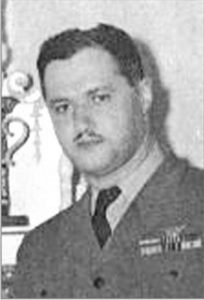
United States Army Air Force
15th Air Force
Killed in Action
Mogel, Edward R., Sgt., 11120668, Purple Heart
301st Bomb Group, 353rd Bomb Squadron
Born 7/7/23
Mrs. Mary Mogel (mother); Harriet M. Finn (sister), 90 Rosseter St., Dorchester, Ma.
Edward and Meredith Finn (nephew and niece in law)
No Missing Air Crew Report, Aircraft: B-17G, no other information known
Meretz Cemetery Association, Quincy, Ma.
Casualty List 5/11/45
American Jews in World War II – 172
Akin to many Second World War Army Air Force casualties, no Missing Air Crew Report is associated with the death of Sergeant Edward Mogel. However, given his rank of Sergeant and award of the Purple Heart medal, it can be reliably assumed that he was an aerial gunner, radio operator, or photographer, and was killed on a combat mission in which his B-17 was not actually lost in combat. The specifics are almost certainly present in the historical records of the 353rd Bomb Squadron or his IDPF, but I don’t have access to those records.
This picture of Sgt. Mogel’s matzeva, taken by genealogical researcher Pamela Filbotte-Hollabaugh, appears at his biographical profile at FindAGrave.
__________
Weinstein, David, S/Sgt., 12084596, Tail Gunner, Air Medal, 3 Oak Leaf Clusters, Purple Heart
97th Bomb Group, 342nd Bomb Squadron
Born 8/14/23
Mr. Abraham Weinstein (father), 1315 Merriam Ave., Bronx, N.Y.
Long Island National Cemetery, Farmingdale, N.Y. – Section H, Grave 9794; Buried 11/15/49
Casualty List 5/23/45
American Jews in World War II – 468
This picture of S/Sgt. Weinstein’s matzeva is by FindAGrave contributor Glenn.
S/Sgt. Weinstein was one of the eleven crew members aboard B-17G 44-6328, an un-nicknamed aircraft which was lost during a mission to the Fortezza Marshalling Yards (northeast of Bolzano) in Italy.
In an incident akin to the downing of the 711th Bomb Squadron’s (447th Bomb Group, 8th Air Force) B-17G TNT KATIE on March 15, 1945, the fuselage of the 342nd Bomb Squadron plane received a direct hit by flak (probably 88mm; possibly 105.cm, or 12.8 cm) in the nose. Alas, sadly unlike TNT KATIE, from which three crewmen were miraculously able to parachute to safety, none of 6328’s crew survived.
As recounted by tail gunner S/Sgt. John D. Jeter (one of three witnesses to the plane’s loss, the others having been bombardier 2 Lt. Jack M. Johnson and T/Sgt. Ted S. Kelting) in Missing Air Crew Report 13818, an anti-aircraft shell exploded in the nose of the plane near the navigator’s astrodome, demolishing the aircraft’s nose as far back as the flight deck, yet leaving the lower nose and chin turret intact. The plane continued in level flight for five more seconds, and then, nosing over, dove to earth from an altitude of 27,000 feet, crashing near Fortezza.
S/Sgt. Jeter noted that #6328 dropped its bombs prematurely, with its bomb-bay doors remaining partially open afterwards. No crewmen or parachutes were seen to emerge from the plane.
__________
Here are a series of Apple Map and Air Photo views of Fortezza and its surroundings – at larger and larger scales as you move “down” the blog post – from DuckDuckGo.
This view shows the location of Fortezza (at the end of the red pointer) in the Italian Tyrol. North of the red-marked international border is Austria.
Moving in, here’s a map showing Fortezza in relation to surrounding towns. The relatively small number of inhabited localities is explained by the area’s topography, which is apparent in the air photo image below…
…which reveals the mountainous nature of the terrain.
Zooming in closer, one sees that Fortezza lies on the Iscaro River. The city is south of the Brenner Pass, which itself was the target of many 15th Air Force bombardment missions.
Zooming in further, you can see the rail line running through the city.
__________
The bomber’s crew comprised:
Pilot: Sullivan, Earle L., 2 Lt.
Co-Pilot: Townsend, Gordon K., Jr., 2 Lt. (Name does not appear in NARA Records at WW II Memorial Database)
Navigator: Wilcox, John E., 2 Lt. (Name does not appear in NARA Records at WW II Memorial Database)
Togglier: Conner, Victor G., Sgt.
Flight Engineer: Tichy, Robert G., T/Sgt.
Radio Operator: McKinney, James Edward “Snookie”, S/Sgt. (Name does not appear in NARA Records at WW II Memorial Database)
Gunner (Ball Turret): Porter, James D., S/Sgt. (Name does not appear in NARA Records at WW II Memorial Database)
Gunner (Right Waist): Tomaszycki, Alfonse J., S/Sgt. (Name does not appear in NARA Records at WW II Memorial Database)
Gunner (Left Waist): Bonner, Thomas W., S/Sgt. (Name does not appear in NARA Records at WW II Memorial Database)
Gunner (Tail): Weinstein, David, S/Sgt.
Photographer: Dudek, Chester A., Sgt.
The following image, at the FindAGrave biographical profile of radio operator S/Sgt. James E. McKinney (contributed by S/Sgt. McKinnney’s cousin NancyG) shows a group of ten men – one of whom (third from right, rear row; the only crew member actually identified in the photo) is S/Sgt. McKinney, and nine other aviators, the latter very likely McKinney’s fellow crew members and thus … the Earle Sullivan crew. Given the arrangement of the men in the photo – four officers in front and six NCO’s standing in back – the four in front would likely include Sullivan, Townsend, and Wilcox. Besides S/Sgt. McKinney, the other five in the rear would include Bonner, Porter, Tichy, Tomaszycki, and Weinstein. Dudek is probably not in the photo. According to NancyG, the specific B-17G plane in the background – Wichita Belle – served as the backdrop for other crew images.
According to the account at FindAGrave, the burial locations of the bomber’s crew were only definitively identified by the summer of 1949, with the crew being returned to the United States for burial by the end of that year.
This image, by FindAGrave contributor Bobby Hunt, shows the collective grave marker at Zachary Taylor National Cemetery for S/Sgt. McKinney and five of his ten fellow crew members. As indicted above, akin to David Weinstein, Sullivan, Townsend, Conner, and Dudek are buried in private cemeteries.
As evidenced by this series of posts – pertaining to Jewish WW II military casualties reported upon in the New York Times – military service by its very nature involves a level of danger and risk in situations unrelated to engagement with enemy forces and actual combat. Such was tragically evidenced on April 20, 1945, in the crash of B-17G Flying Fortress 44-6441 (Mary Rose) of the 301st Bomb Group near Caserta, Italy, while piloted by 1 Lt. Robert L. Francis. None of the plane’s twenty-one crew and passengers survived.
Though I don’t have the Accident Report, according to Jing Zhou’s website B-17 Bomb Flying Fortress (which carries a list of the plane’s crew and passengers, and includes a photo of the wreck), the bomber’s loss may have been attributable to bad weather, as “The report clarifies how the aircraft hit the side of the hill after the pilot aborted the landing in poor visibility.” Though not specifically delineated in Missing Air Crew Report 15496, given the marking on the plane’s tail (circle 4), the plane may have been assigned to the 419th Bomb Squadron.
Among the plane’s passengers were Captain Howard A. Leeser, Captain Seymour S. Weisberger, and T/5 Lisa Zucker.
Leeser, Howard A., Capt., 0-432475
Born Missouri, 1/28/18
Mr. and Mrs. Arthur [3/7/83-6/28/25] and Flossie (Marks) [5/2/90-1/20/63] Leeser (parents), Tulsa, Ok.
Kane, Pa.
New Mount Sinai Cemetery, Afton, Mo. – Dora Weigel Plot, Lot 153, Section I, Grave 9; Buried 12/48
American Jews in World War II – 505
Weisberger, Seymour S., Capt., 0-1579282
15th Air Force, 5th Photo Reconnaissance Group
Born 9/2/17
Mr. and Mrs. Harry and Belle Weisberger (parents), 575 Westlake Ave., Barberton, Oh.
Rose Hill Cemetery, Akron, Oh.
The Akron Beacon Journal 5/1/45
American Jews in World War II – 503
This image of Captain Weisberger, provided by 57th Bomb Wing Researcher Patti Johnson is from the Akron Beacon Journal of May 1, 1945, and appears at Captain Weisberger’s FindAGrave profile.
Zucker, Lisa, T/5, A-200820
15th Air Force, 6720th Headquarters Platoon
Born 4/19/13
Mr. Michael Zucker (brother), 6718 7th Ave., Los Angeles, Ca.
Bronx County, N.Y.
Hillside Memorial Park, Los Angeles, Ca. – Valley of Remembrance, Plot 4-313-5
The Knickerbocker News (Albany, N.Y.) 1/30/43
Los Angeles Times 5/4/44, 3/9/49, 3/14/49
American Jews in World War II – not listed (error … see correction below!)
Like Captain Kamen, T/5 Lisa Zucker is an example of the many Jewish WW II military casualties whose names never appeared in American Jews in World War II. Ironically; fortunately, information and photographs about her existed well before the sad event of April 20, 1945, in the form of newspaper articles in The Knickerbocker News (of Albany, New York) of January 30, 1943, and The Los Angeles Times of May 4, 1944. These news items are shown below, the former accessed via Thomas M. Tryniski’s FultonHistory website.
[Correction, December, 2024!… T/5 Zucker’s name appears on page 57 of American Jews in World War II, appropriately under the state of California. Thanks to Rabbi Joseph Topek of Stony Brook University, who informed me of the discrepancy in this post!]
~~~~~~~~~~~~~~~

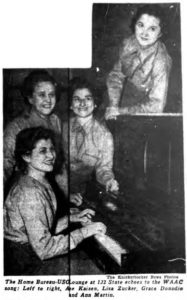
Albany WAACs Don’t Lack for Dates or Hospitality
First in a Series
The little WAAC who was none too sure of herself gives you an idea of how Albany’s ladies in khaki get along for entertainment.
Preparing to go on duty, she was standing in front of a mirror fluffing her hair. On average, how often do WAACs gave dates?
“Well, I only have about a couple a week,” she said, “bit a lot of the girls have three or four. I guess I have some things to learn.”
Almost always WAAC dates are with soldiers or sailors stationed in Albany and what with propinquity playing the part it does in human affairs, quite a few couples have started “going steady”. This is pretty largely to the credit of the United Service Organizations for many romances in Albany have started at USO dances at the Albany Yacht Club.
Albany WAACs, however are not wholly dependent upon men for entertainment. Groups of them go to the picture shows (22 cents admission if they are in uniform), swim or use the gym at the Jewish Community Center and YMCA or bowl (one alley gives them a cut rate one night a week).
There are two lounges available to the girls. One is a portion of the lobby of the hotel in which they live and the other is in a State St. store.
The latter is operated jointly by the Albany County Home Bureau and the USO and is equipped with a ping-pong table, a radio, record-player, smoking stands and desks for letter writing. It also has a gas range.
“The other night,” Second Officer Marjorie Hunt said, “about 15 girls brought food and prepared their own supper. It is nice to have a place where you can be that free to do as you please.”
Albany churches have “outdone themselves” in inviting WAACs to church supper and entertainments, Second Officer Hunt said. “Some of them have taken the girls bowling, and, in general, have made it pleasant for them,” she said. “The City Club, the Albany Institute of History and Art and the Albany Public Library also have been cooperative.
“Over the holidays,” Second Officer Hunt said, “a lot of the girls were invited to homes of Albany people. Between holidays there usually isn’t so much of that.”
If male civilians can arrange to meet a WAAC, they need not quail at the thought of dating a girl in uniform when they are not. The WAACs don’t have to wear their uniforms when off duty – and most of them can have dates almost any night.
__________
Here is a photo of PFC Zucker from the Los Angeles Times of May 4, 1944.
HONORS IN ITALY – Wac. Pfc. Lisa Zucker, Los Angeles, attached to 15th Air Force in Italy, stands at attention as Maj. F.H. Cratheron awards good conduct ribbon.
 Another Incident: An aviator who parachuted and returned to duty
Another Incident: An aviator who parachuted and returned to duty
Berman, Jacob, 2 Lt., 0-2056684, Bombardier, Purple Heart
14th Air Force, 308th Bomb Group, 373rd Bomb Squadron
Parachuted 15 miles north of Kunming, China; Returned to duty; Hospitalized (Lightly injured in bailout)
Born 1924
Mr. Nathan Berman (father), 3210 Fillmore Ave., Brooklyn, N.Y.
MACR 14467, Aircraft B-24M 44-50283, Pilot 2 Lt. Wayne V. Jorgensen, 9 crew – 8 survivors
The Aluminum Trail – 404
American Jews in World War II – 275
Statement in Missing Air Crew Report: “Plane No, 44-50283 took off on a shipping strike from Lulian, China, at 1831 hours, 19 April 1945. On return from mission all crew members bailed out fifteen (15) miles north of Kunming, China due to fuel shortage at about 0348 hours, 20 April 1945. 2 Lt. William B. Ealey, 0-553955 [radar officer], was killed in the bailout and Sgt. [Stephen] Blacet [Gunner] is missing. [Returned to duty May 15 – lightly injured in bailout] All other crew members are hospitalized at 95th Station Hospital, APO 627. Extent of injuries unknown.”
Other crew members:
Pilot: Jorgensen, Wayne V., 2 Lt.
Co-Pilot: Emery. Frederick V., 2 Lt.
Navigator: Bittle, Claude E., 2 Lt.
Flight Engineer: Hoyler, Edward W., Sgt. – Lightly injured in bailout
Radio Operator: Wheeler, Woodrow, T/Sgt.
Gunner: Ratzin, Thomas, Sgt.
Soviet Union
Red Army
U.S.S.R. (C.C.C.Р.), Red Army [РККА (Рабоче-крестьянская Красная армия)]
Agranovich, Zelik Isaevich – Senior Sergeant (Агранович, Зелик Исаевич – Старший Сержант)
Deputy Battalion Commander – Political Section (Заместитель Политчасти Командира Батальона)
68th Autonomous Tank Brigade
Born 1912; City of Nizhneudinsk, Irkutsk Oblast
Buried: Fraternal Cemetery, Laisov Village, Brandenburg, Germany – Row 2, Grave 5
Bloomenkrants, Isaak Iosifovich – Major (Блюменкраиц, Исаак Иосифович – Майор)
Political Agitator (Агитатор)
1107th Self-Propelled Artillery Regiment, 3rd Tank Corps, 2nd Tank Army
Died of wounds
Born 1915; City of Minsk, Minsk Oblast, Belorussian SSR
Place of burial: Unknown
Entin, Iosif Yakovlevich – Guards Lieutenant (Энтин, Иосиф Яковлевич – Гвардии Лейтенант)
Tank Commander (Командир Танка)
1st Belorussian Front, 11th Autonomous Guards Heavy Tank Brigade, 90th Guards Heavy Tank Regiment
Born 1914; Pochenskiy Raion, Bryansk Oblast
Buried: Brandenburg, Germany
Memorial Book of Jewish Soldiers Who Died in Battles Against Nazism – 1941-1945 (Книги Памяти евреев-воинов, павших в боях с нацизхмом в 1941-1945 гг) Volume IV, p. 533; Volume V, p. 160
Glikman, Leonid Mikhaylovich – Guards Junior Technician-Lieutenant (Гликман, Леонид Михайлович – Гвардии Младший Техник-Лейтенант)
Tank Technician (Техник Танковый)
57th Guards Tank Brigade
Born 1919; Odessa
Buried: Poland
Kantarovich, Roman Iosifovich – Guards Lieutenant (Кантарович, Роман Иосифович – Гвардии Лейтенант)
Armor (Specific crew position or assignment unknown) (“Танковый”)
Place of burial: Unknown
Memorial Book of Jewish Soldiers Who Died in Battles Against Nazism – 1941-1945 (Книги Памяти евреев-воинов, павших в боях с нацизхмом в 1941-1945 гг) Volume V, p. 700
Malamud / Malomud, Iosif Shulimovich, – Junior Lieutenant (Маламуд / Маломуд, Иосиф Шульимович – Младший Лейтенант)
Rifle Platoon Commander (Командир Стрелкового Взвода)
250th Rifle Regiment, 82nd Rifle Division, 47th Army
Born: 1913, Vinnitskaya Oblast
Wife: Nina Zalmanov / Zimkovna Malamud / Molomud
First place of burial: Nider-Nayendorf, Brandeburg, Germany
Neer, Vevik Manikovich – Junior Lieutenant (Неер, Вевик Маникович – Младший Лейтенант)
Self-Propelled Gun Commander (Командир Самоходной Установии)
1203rd Self-Propelled Artillery Regiment
Born 1912; Odessa
Buried: City of Bernau (southeast, “elevation 89”), Brandenburg, Germany
Peysakhov, Mordukh Khaymovich – Senior Sergeant (Пейсахов, Мордух Хаймович – Старший Сержант)
Chief – “Walkie Talkies” (Начальник Рации)
2nd Ukranian Front, 84th Tank Regiment
Born 1906; Shumyachskiy Raion, Smolensk Oblast
Buried: Moravia, Czechoslovakia
Memorial Book of Jewish Soldiers Who Died in Battles Against Nazism – 1941-1945 (Книги Памяти евреев-воинов, павших в боях с нацизхмом в 1941-1945 гг), Volume V, p. 160; Volume VI, p. 183
Rozenflan, Pavel Filippovich – Guards Junior Sergeant (Розенфлан, Павел Филиппович – Гвардии Младший Сержант)
Gun Commander (Командир Орудия)
53rd Guards Tank Brigade
Killed at city of Baruth, Brandenburg, Germany
Born 1925; City of Dnepopetrovsk
Buried: Germany, city of Baruth, northern outskirts
Veytman, Aleksandr Aleksandrovich – Senior Sergeant (Вейтман, Александр Александрович – Старший Сержант)
Gun Commander (Командир Орудия)
3rd Guards Motorized Rifle Brigade, 4th Guards Tank Corps
Died of wounds at 165th Medical-Sanitary Battalion
Born 1903
Buried: Germany, city of Muskau, Collective Grave
France
Killed in Action
Franck, Marcel Frederic Jean Baptiste (AC-21P-187386)
Armée de Terre, Direction Générale des Etudes et de la Recherche
Died at Flossenburg Concentration Camp
Born 8/27/07, Tourcoing, Nord, France
Touati, Albert Abraham (AC-21P-157194), at Hesselbronn, Germany
(from Algeria), Armée de Terre, 41eme Groupe Colonial de Force Terrestre Antiaériennes (41st Colonial Anti-Aircraft Group)
Died of wounds
Born 2/16/23, Sidi bel Abbes, Algerie
Poland
Killed in Action
Baugarten, Jan, Cpl. (Germany, Saxony, Nieksy (Operation Bautzen Elba)
1st Tank Brigade
Born Piadyki (d. Kolomyja) [Ivano-Frankivsk, Ukraine?], Poland, 1906
Mr. Jozef Baugarten (father)
Missing in Action; No Known Grave
Jewish Military Casualties in the Polish Army in World War II (Volume I) – 82
Bilski, Wiktor, Pvt. (Germany, Saxony, Odernitz)
1st Motorized Infantry Brigade
Born Poland, Grodno; 1902
Mr. Leon Bilski (father)
Missing in Action; No Known Grave
Jewish Military Casualties in the Polish Army in World War II (Volume I) – 82
Bocian, Berek, 2 Lt. (Germany, Brandenburg, Potsdam, Berlin (Operation Brand-Berlin))
11th Infantry Regiment
Born Sochaczew, Mazowieckie, Poland, 1921
Mr. Hercz Bocian (father)
Jewish Military Casualties in the Polish Army in World War II (Volume I) – 9
Borzwejg, Saul, Cpl. (Germany, Saxony, Nieksy (Operation Bautzen Elba))
1st Motorized Infantry Brigade
Born Poland, Mazowieckie, Warsaw; 1910
Mr. Pesach Borwejg (father)
Jewish Military Casualties in the Polish Army in World War II (Volume I) – 10
Cogiel, Arik (Germany, Brandenburg, Paulinnau (Operation Brand-Berlin))
12th Infantry Regiment
Born Buknic, Poland, 1920
Mr. August Cogiel (father)
Jewish Military Casualties in the Polish Army in World War II (Volume I) – 14
Cudny, Henryk, 2 Lt. (Germany, Saxony, Rietschen (Operation Bautzen-Elba))
12th Infantry Regiment
Born Poland, Mazowieckie, Warsaw; 1921
Mr. Jan Cudny (father)
Jewish Military Casualties in the Polish Army in World War II (Volume I) – 14
Drupiewski, Adam, Pvt. (Germany, Brandenburg, Wriezen (Operation Brand Berlin))
Intelligence Company
Born USilver StarR, Woronez (Voronezh?); 1922
Mr. Beniamin Drupiewski (father)
Jewish Military Casualties in the Polish Army in World War II (Volume I) – 17
Finkielsztein, Nuta, Pvt. (Germany, Saxony, Daubitz)
37th Infantry Regiment
Born Sarnaki (d. Losice) [Mazowieckie?], Poland, 1913
Mr. Abraham Finkielsztein (father)
Jewish Military Casualties in the Polish Army in World War II (Volume I) – 20
Fuss, Herman, Pvt. (Germany, Brandenburg, Tuchen (Operation Brand-Berlin))
8th Infantry Regiment
Born Chyrow, Poland, 1911
Mr. Jakub Fuss (father)
Jewish Military Casualties in the Polish Army in World War II (Volume I) – 22
Gleich, Michal, Pvt. (Germany, Saxony, Milkel (Operation Bautzen-Elba))
17th Infantry Regiment
Born Kijow, Opolskie, Poland, 1915
Zgorzelec Military Cemetery, Zgorzelec, Poland
Mr. Jozef Gleich (father)
Jewish Military Casualties in the Polish Army in World War II (Volume I) – 24
Goldfeder, Pvt. (Germany, Saxony, Bautzen (Operation Bautzen Elba))
16th Tank Brigade
Missing in Action; No Known Grave
Jewish Military Casualties in the Polish Army in World War II (Volume I) – 86
Grubman, Chaim, Capt. (Poland, Jaroslaw)
2nd Reserve Regiment
Born Ukraine, Khmelnytsky, Kamieniec Podolski; 1908
Mr. Szmuel Grubman (father)
Jewish Military Casualties in the Polish Army in World War II (Volume I) – 26
Hartfelder, Zygmunt, 2 Lt. (Germany, Saxony, Sdier (Operation Bautzen-Elba))
17th Infantry Regiment
Born Jaroslaw, Poland, 1923
Mr. Jan Hartfelder (father)
Jewish Military Casualties in the Polish Army in World War II (Volume I) – 28
Holc, Mieczyslaw, Pvt. (Germany, Saxony, Odernitz (Operation Bautzen-Elba))
1st Motorized Infantry Brigade
Born 1924
Mr. Aleksander Holc (father)
Jewish Military Casualties in the Polish Army in World War II (Volume I) – 30
Hupert, Hugo, Cpl. (Germany, Saxony, Odernitz (Operation Bautzen Elba))
1st Motorized Infantry Brigade
Born 1908
Mr. Markus Hupert (father)
Missing in Action; No Known Grave
Jewish Military Casualties in the Polish Army in World War II (Volume I) – 88
Kasper, Eliasz, Pvt. (Germany, Brandenburg, Wriezen (Operation Brand Berlin))
12th Infantry Regiment
Born Cznowicze (d. Nieswicz), Poland, 1902
Mr. Daniel Kasper (father)
Missing in Action; No Known Grave
Jewish Military Casualties in the Polish Army in World War II (Volume I) – 89
Kuperman, Zygfryd, First Sergeant (Germany, Torgelow)
3rd Infantry Regiment
Born Bielsko-Biala, Slaskie, Poland, 1915
Mr. Henryk Kuperman (father)
Jewish Military Casualties in the Polish Army in World War II (Volume I) – 42
Landau, Hirsz, First Sergeant (Germany, Friedrichsthal (Operation Brand Berlin))
1st Light Artillery Regiment
Born Poland, Malopolskie, Krakow, 1914
Mr. Jakub Landau (father)
Missing in Action; No Known Grave
Jewish Military Casualties in the Polish Army in World War II (Volume I) – 43
Lubiczew, Salomon, Pvt.
11th Infantry Regiment
Born Szabelnia, Poland, 1924
Mr. Jakub Lubiczew (father)
Jewish Military Casualties in the Polish Army in World War II (Volume I) – 92
Matela, Zygmunt, Sgt. (Germany, Saxony, Nieksy (Operation Bautzen Elba))
1st Armoured Infantry Brigade
Mr. Jakow Matela (father)
Jewish Military Casualties in the Polish Army in World War II (Volume I) – 48
Nikonczuk, Michal, Cpl. (Germany, Dannenberg)
5th Infantry Regiment
Born Holowin, Poland, 1918
Mr. Dawid Nikonczuk (father)
Jewish Military Casualties in the Polish Army in World War II (Volume I) – 52
Okret, Oskar, Capt. (Operation Brand Berlin)
5th Infantry Division
Born Poland, Lodzkie, Lodz; 1908
Mr. Pawel Okret (father)
Jewish Military Casualties in the Polish Army in World War II (Volume I) – 52
Pilac, Leon, Pvt. (Field Hospital 8 (Operation Brand Berlin))
Poland, Polish People’s Army
Born Russia; 1911
Mr. Adam Pilac (father)
Jewish Military Casualties in the Polish Army in World War II (Volume I) – 54
Polakow, Siemion, Sgt. (Germany, Torgelow (Operation Brand Berlin))
1st Communications Battalion
Born Odessa Oblast, Odessa; 1924
Mr. Nisym Polakow (father)
Jewish Military Casualties in the Polish Army in World War II (Volume I) – 55
Rotberg, Jozef, Cpl. (Germany, Brandenburg, Danewitz (Operation Brand Berlin))
7th Infantry Regiment
Born Ukraine, Lwow, Olesko; 1912
Mr. Salomon Rotberg (father)
Jewish Military Casualties in the Polish Army in World War II (Volume I) – 58
Rozental, Aleksander, Pvt.
3rd Infantry Regiment
Born Poland, Mazowieckie, Warsaw; 1916
Mr. Pawel Rozental (father)
Missing in Action; No Known Grave
Jewish Military Casualties in the Polish Army in World War II (Volume I) – 96
Slupski, Mieczyslaw, Lt. (Germany, Saxony, Bautzen (Operation Bautzen Elba))
26th Infantry Regiment
Born Poniatowka (d. Grodno) [Lubelskie?], Poland, 2/16/23
Jewish Military Casualties in the Polish Army in World War II (Volume I) – 62
Sosnowicz, Chaim, First Sergeant (Germany, Saxony, Nieksy (Operation Bautzen Elba))
4th Tank Brigade
Mr. Abram Sosnowicz (father)
Jewish Military Casualties in the Polish Army in World War II (Volume I) – 63
Szafran, Chaim, First Sergeant (Operation Bautzen Elba)
4th Tank Brigade
Mr. Abram Szafran (father)
Jewish Military Casualties in the Polish Army in World War II (Volume I) – 64
Wajs, Jan, Pvt. (Germany, Torgelow (Operation Brand Berlin))
3rd Infantry Regiment
Born Nowomiejska, Warminsko-Mazurskie, Poland, 1920
Mr. Szymon Wajs (father)
Jewish Military Casualties in the Polish Army in World War II (Volume I) – 72
Weintraub, Bronislaw, 2 Lt. (Germany, Saxony, Rietschen (Operation Brand Berlin))
13th Infantry Regiment
Born Poland, Malopolskie, Krakow, 10/12/02
Mr. Julian Weintraub (father)
Jewish Military Casualties in the Polish Army in World War II (Volume I) – 73
Werdach, Zygmunt, First Sergeant (Germany, Saxony, Nieksy (Operation Bautzen Elba))
4th Tank Brigade
Mr. Julian Werdach (father)
Jewish Military Casualties in the Polish Army in World War II (Volume I) – 73
Wiertel, Leon, WO (Operation Brand Berlin)
9th Infantry Regiment
Born Poland, Stanislawow; 1911
Mr. Marek Wiertel (father)
Jewish Military Casualties in the Polish Army in World War II (Volume I) – 74
Ziubisz, Beniamin (Poland, Warsaw)
Poland, Polish People’s Army
Born Poland, Rowne; 1904
Mr. Szymon Ziubisz (father)
Jewish Military Casualties in the Polish Army in World War II (Volume I) – 77
England
Killed in Action
Goldberg, David, Rifleman, 6855382, Killed by artillery at Traghetto, Italy
King’s Royal Rifle Corps, 1st Battalion
Mr. S. Goldberg (brother), 87 Duelston Road, London, E5, England
Argenta Gap War Cemetery, Argenta, Ferrara, Italy – II,A,15
The Jewish Chronicle 6/8/45
We Will Remember Them – A Record of the Jews Who Died in the Armed Forces of the Crown 1939 – 1945 – 92
Czechoslovakia
Killed in Action
Frischling, Chaim, Pvt.
1st Czechoslovak Army Corps, 1st Communication Battalion
Died of wounds (battle at Sueany) 4/23/4, at Vrútky (hospital), Zilina, Slovakia
Born Frystat, Czechoslovakia; 12/14/17
Jewish Cemetery, Vrutky, Zilina, Slovakia
Hamburg, Ludovit, Pvt.
1st Czechoslovak Army Corps, 4th Infantry Brigade
Born Czechoslovakia, Dravce, Levoea; 10/11/19
United States Army
Another Incident: Award of Bronze Star Medal
Spanover, Abraham, S/Sgt., 32494837, Bronze Star Medal (For actions at Treuf, Germany)
United States Army
Born 1921
Mr. Isie Spanover (?), Sgt. Max Spanover (brother), 1135 E. 51st St., Brooklyn, N.Y.
Brooklyn Eagle 7/15/45
American Jews in World War II – Not listed
OVER THERE
Brooklyn Eagle
July 15, 1945
For Administrating first aid to wounded comrades while under fire, Staff Sergeant Abraham Spanover, of 1135 51st St., has received the Bronze Star Medal.
An infantryman, Sergeant Spanover performed his heroic act April 20, near Treuf, Germany.
“After being surprised by three enemy tanks, which killed and wounded several members of his squad, Sergeant Spanover ordered his squad to withdraw while he stayed behind to care for the wounded,” his citation says.
“For two hours he crawled over flat, open terrain which was subject to heavy enemy fire, administering first aid to the wounded. Despite the constant enemy fire, he carried on until aid men arrived to evacuate the wounded.”
References
Books
Dublin, Louis I., and Kohs, Samuel C., American Jews in World War II – The Story of 550,000 Fighters for Freedom, The Dial Press, New York, N.Y., 1947
Giles, Janice H., The Damned Engineers, Houghton Mifflin Company, Boston, Ma., 1970
Grimm, Jacob L., Heroes of the 483rd: Crew Histories of a Much-Decorated B-17 Bomber Group During World War II, Georgia (?), 483rd Bombardment Group Association, 1997.
Meirtchak, Benjamin, Jewish Military Casualties in the Polish Armies in World War II: I – Jewish Soldiers and Officers of the Polish People’s Army Killed and Missing in Action 1943-1945, World Federation of Jewish Fighters Partisans and Camp Inmates: Association of Jewish War Veterans of the Polish Armies in Israel, Tel Aviv, Israel, 1994
Morris, Henry, Edited by Gerald Smith, We Will Remember Them – A Record of the Jews Who Died in the Armed Forces of the Crown 1939 – 1945, Brassey’s, United Kingdom, London, 1989
Parker, Danny S., Fatal Crossroads: The Untold Story of the Malmédy Massacre at the Battle of the Bulge, Da Capo Press, Cambridge, Ma., 2013
Pergrin, Colonel David E., and Hammel, Eric M., First Across the Rhine – The 291st Engineer Combat Battalion in France, Belgium, and Germany, Ballantine Books, New York, N.Y., 1989
Quinn, Chick Marrs, The Aluminum Trail –China-Burma-India World War II 1942-1945 – How & Where They Died, Chick Marrs Quinn, 1989
Memorial Book of Jewish Soldiers Who Died in Battles Against Nazism – 1941-1945 – Volume IV [Surnames beginning with Т (T), Ф (F), Х (Kh), Ц (Ts), Ч (Ch), Ш (Sh), Щ (Shch), Э (E), Ю (Yoo), and Я (Ya)], Maryanovskiy, M.F., Pivovarova, N.A., Sobol, I.S. (editors), Union of Jewish War Invalids and Veterans, Moscow, Russian Federation, 1997
Memorial Book of Jewish Soldiers Who Died in Battles Against Nazism – 1941-1945 – Volume V [Surnames beginning with А (A), Б (B), В (V), Г (G), Д (D), Е (E), Ж (Zh), З (Z), И (I), К (K)], Maryanovskiy, M.F., Pivovarova, N.A., Sobol, I.S. (editors), Union of Jewish War Invalids and Veterans, Moscow, Russian Federation, 1998
Memorial Book of Jewish Soldiers Who Died in Battles Against Nazism – 1941-1945 – Volume VI [Surnames beginning with Л (L), М (M), Н (N), О (O), П (P), Р (R), С (S), Т (T), У (U), Ф (F), Х (Kh), Ц (Ts), Ч (Ch), Ш (Sh), Щ (Shch), Э (E), Ю (Yoo), Я (Ya)], Maryanovskiy, M.F., Pivovarova, N.A., Sobol, I.S. (editors), Union of Jewish War Invalids and Veterans, Moscow, Russian Federation, 1999
Memorial Book of Jewish Soldiers Who Died in Battles Against Nazism – 1941-1945 – Volume IX [Surnames beginning with all letters of the alphabet], Maryanovskiy, M.F., Pivovarova, N.A., Sobol, I.S. (editors), Union of Jewish War Invalids and Veterans, Moscow, Russian Federation, 2006
United States National Archives (College Park, Maryland)
Records Group 153: Case File 16-293-16
Records Group 92: Missing Air Crew Report 13817
Other References
French WW II Casualties – Soldiers who died during the Second World War – “Database of soldiers who died during the Second World War, conscripts and active soldiers, regular and resistant soldiers (Militaires décédés au cours de la Seconde Guerre mondiale (Base de données des militaires décédés au cours de la Seconde Guerre mondiale, conscrits et militaires d’active, soldats réguliers et résistants), at Memoire des Hommes), at sga.defense.gouv.fr
Chief Pharmacists’s Mate Leon Aaron Rutberg
American World War II Orphan’s Network – Biography by Carole Rutberg Silverman
Navy Medicine – Medical Power for Naval Superiority: Killed in Action Memorial – World War Two
257 Central Park West – at Wikipedia
March 31, 2021
March 31, 2021


